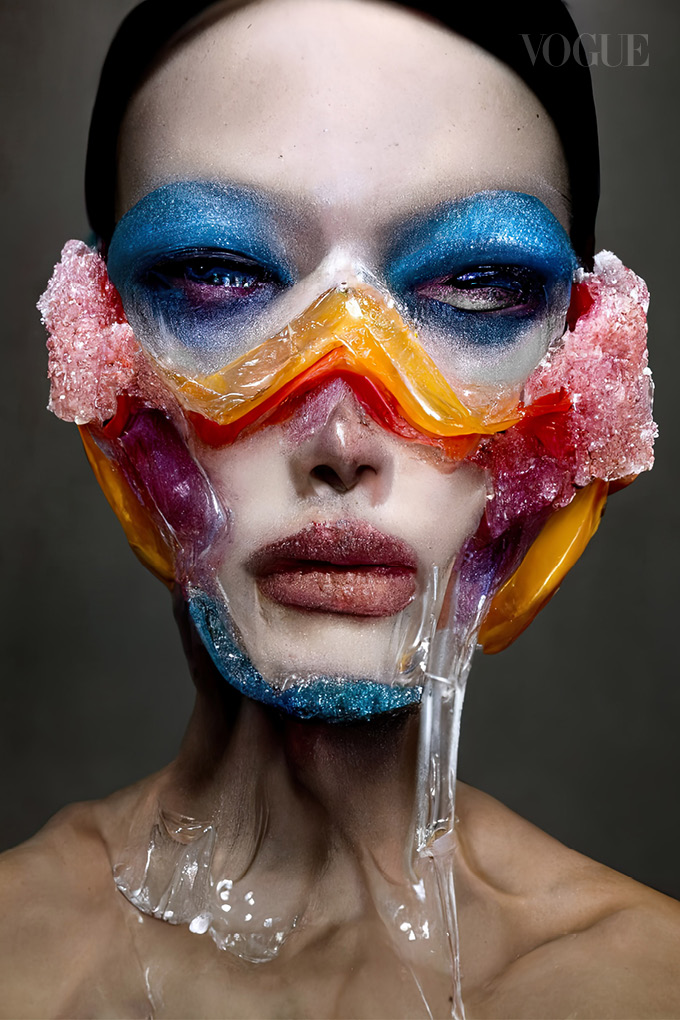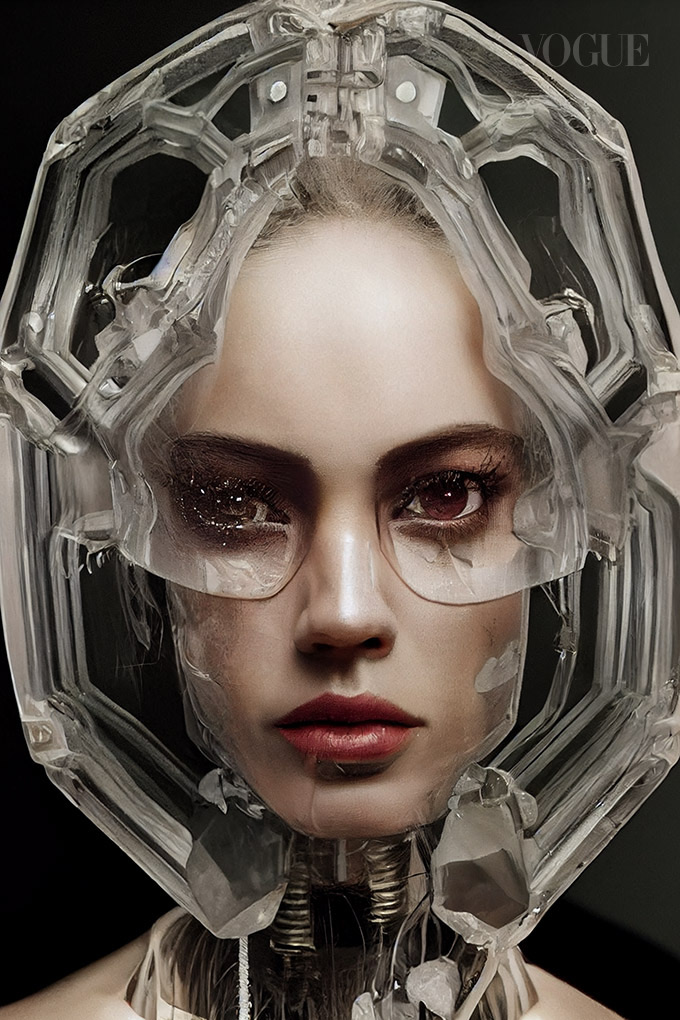What will become of us? As technology hurtles forward, arresting AI-generated beauty created by artist Terry Gates prompt us to examine what this rush towards the metaverse means for the tangible, elemental self. Made in collaboration with Vogue Singapore, his work featuring AI metahumans leans into the biophilic where CGI faces fuse primordial spawn-like elements with lustrous, of-the-earth crystals.
The future of AI beauty
Mucin. Demeter. Quartz and agate. Selene on the ascendant. Not a spell or chant, but prose and curious keywords beauty director Alli Sim sent to Gates for our most arresting beauty project yet. Running a program called MidJourney through a Discord server, Gates uploads these text prompts, which produce four images 30 seconds later. While Gates then has the power to add new text or reiterate these concepts, thereby changing the images each time, the end result is always random and filled with surprise. As with life, the machine learning algorithm also adapts.
The collaboration, which aimed to discover images that are intriguing and beautiful from the artist’s perspective, produced over 1,000 images before the final selection of nine mythical faces before you. “Machine learning algorithms build a model based on data training sets they are given,” Gates explains.
“So, for example, if the data set contains millions of images of human faces, it will be able to ‘learn’ what the characteristics of a human face are and how they look. It is then able to create a unique image that is essentially a prediction of something that will resemble a human face. Then the outcomes are evaluated against other real images, the parameters tweaked and the process is run over and over again. As a result, it gets better and better at predicting what human faces look like.”
AI’s pace of progress
Just as AI can rapidly improve, so too can expressions of creativity. It took just six weeks from the creation of Gates’ original images for the stark advancements in AI technology seen his remastered photos.
As an artist, Gates says “the pace at which you can generate new art is orders of magnitude faster using AI, with photography if you wanted to revisit a shoot it would double your cost and time invested. With AI, the cost and time investment of redoing images or creating variations is almost nothing. So this is something new that was never possible with photography. I guess you could think of it like a piece of software, where you start with beta then version 1, version v2 etc which is essentially happening with the AI models as they are refined and the training data improves. So determining when something is done is much more flexible than a photoshoot.”
With one foot in this realm and another firmly staked in the metaverse, it’s hard to not stop and stare at these otherworldly hybrids. Is the future of beauty bright or dystopian? One thing is for certain—it’s ours to determine.
Swipe right to see Gates’ original images; and right for the artist’s remastered versions created just weeks later with the same AI tool.
“A new form of image making has emerged through AI research, giving us the ability to create realistic images and art from a description in natural language. For this story we imagined a photographic inspired beauty story that was generated entirely from text inputs,” explains Gates.
“My whole photographic career I have been drawn to technology and what impact it can have on the image making process. For years I specialised in creating VR fashion shoots like seen in the inaugural issue of Vogue Singapore,” says Gates. “Those shoots evolved into mixing 360 photography with 3D and then further experimenting with 3D where I am mostly focused now, creating virtual influencers for brands like Vogue Australia and L’Oréal. I’m always experimenting with new ideas and technology around image making. So when I saw what was happing with AI it seemed an obvious place to experiment and explore its implications.”
“I think there’s a clear leap in the visual quality of the image and fidelity of the faces with the new images,” Gates explains. But at what gain or cost to the nuance and spirit of the artwork itself? “I prefer some of the originals or at least parts of them… they are more grainy/noisy which also adds similar context like the contrast between analogue and digital photography. They are more abstract because of the deformities of the faces which to me is visually appealing and adds to the overall sentiment of the art.”
“I was looking for beautiful images rather than beautiful faces. Often, the things we find interesting or beautiful in art aren’t defined by proportions or beauty standards, but by something that is unique and intriguing,” says Gates.
“I think technology overall only enhances your ability to express ideas,” he says, on how technology has enhanced or challenged his vision as an artist. AI in particular represents a paradigm shift in the way we imagine. With a simple idea you can generate infinite realistic variations with very little effort and in very little time.”
Will artificial intelligence change the face of beauty forever? “I’m not sure if it will change the way we perceive beauty, I think of it more as art and art definitely can inspire different beauty trends,” shares Gates.
“I think this medium’s power is the power of imagination and this kind of tool can increase our own imagination by orders of magnitude. I hope people will find some beauty in the strangeness of these images. And if that translates into self-acceptance in anyway, then the machines have taught us something valuable.”
Gates who admits that the most surprising thing when comparing the original images to remastered images was the improvement in quality, particularly with faces. “The newer versions’ faces are much more realistic, defined and clear. This kind of AI generated art is so new and I think it gives us a glimpse of the exponential age we are entering. I expect even larger leaps in quality within the coming months.”
His favourite part of this creative process? “The most enjoyable part is the surprise and randomness of it,” he shares. “Also the collaboration, working around your concept and words to find something intriguing and beautiful from my perspective, that would fit within the brief. It was never really frustrating, more of like a learning experience, trying to understand how things will be interpreted or how I could modify the prompt to get better results. Well over a thousand images were generated during my process.”
Step into Vogue’s New World and view the portraits up close
- Visit Vogue’s New World on Spatial.io
- Create an account or log in to your existing account
- Build and dress your avatar in Vogue’s exclusive designs by Yimeng Yu
- Enter and navigate the space using your mouse and keyboard to interact with the four clickable points
The virtual world will be launched in two phases with the first part activated today and the next in tandem with Vogue’s second anniversary issue in October 2022. The experience on Spatial.io is best optimised for desktop, mobile and oculus headsets. Sign up to stay up to date on the launch.
The September ‘Fashion’s New World’ issue of Vogue Singapore is available for sale online and in-store from 5 September 2022.





















